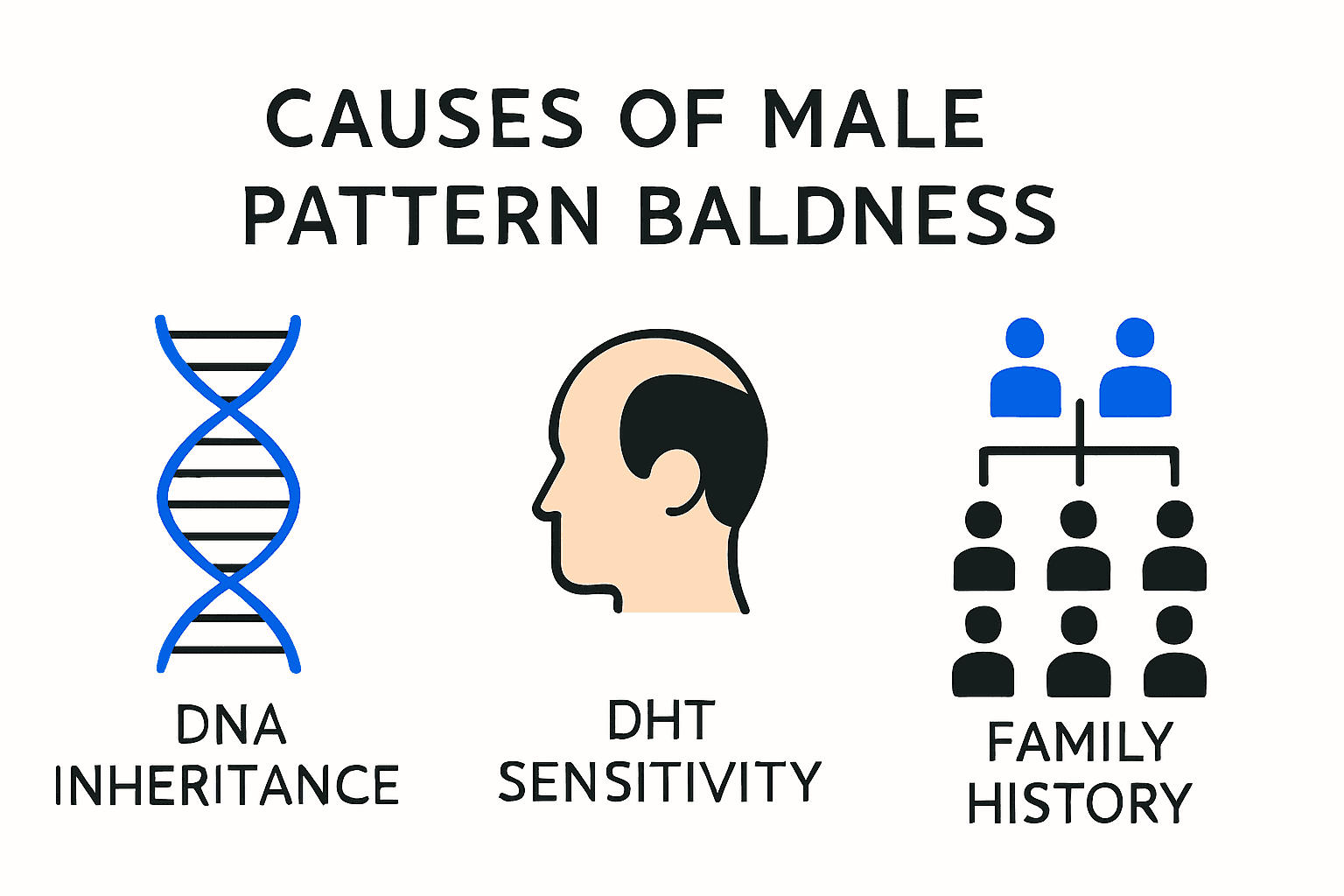Blog
Learning Materials
Male Pattern Baldness Treatment: Proven Solutions for 2025
Updated: July 15, 2025

Millions of men worry about thinning hair every year and male pattern baldness is the most common culprit. Here’s something that might surprise you. Up to 50 percent of men can expect to face this type of hair loss during their lives according to NIH research. But the real shock is that the ways to fight baldness in 2025 look a lot different than you might expect. New treatments and tracking tech are changing what’s possible for anyone hoping to get ahead of hair loss.
Table of Contents
- Understanding Male Pattern Baldness And Its Causes
- Latest Medical And At-Home Treatment Options
- Tracking Hair Growth Progress Effectively
- Personalized Hair Care Tips And Brand Solutions
Quick Summary
| Takeaway | Explanation |
|---|---|
| Genetic Influence on Hair Loss | Male pattern baldness is primarily driven by genetic factors, particularly sensitivity to dihydrotestosterone (DHT), which causes hair follicle miniaturization. |
| Effective Treatment Options | Proven treatments such as Finasteride and Minoxidil significantly slow hair loss progression, while emerging therapies like Pyrilutamide and advanced non-invasive technologies like Low-Level Laser Therapy (LLLT) are also gaining traction. |
| Importance of Tracking Progress | Systematic tracking of hair growth through clinical assessments, technology, and personal monitoring is essential to gauge treatment effectiveness and make informed decisions. |
| Personalized Hair Care Approaches | Customized hair care that considers individual genetic and hormonal profiles, combined with lifestyle and nutritional support, represents the future of managing male pattern baldness. |
| Holistic Strategies for Improvement | Integrating stress reduction, dietary adjustments, and targeted supplements into treatment plans can enhance overall hair health and support effective hair restoration efforts. |
Understanding Male Pattern Baldness and Its Causes
Male pattern baldness represents a complex genetic condition that impacts millions of men worldwide. Research from the National Institutes of Health reveals that up to 50% of men experience this progressive hair loss condition, making it the most common form of hair loss among males.
The Genetic Roots of Hair Loss
At the core of male pattern baldness lies a powerful genetic mechanism. Your hair loss story is essentially written in your DNA. Androgens play a critical role in this process, with dihydrotestosterone (DHT) being the primary hormone responsible for follicular miniaturization. Scientific studies demonstrate that men with a specific genetic sensitivity to DHT experience a gradual shrinking of hair follicles.
The hereditary nature of this condition means that if your father or grandfather experienced significant hair loss, you are more likely to follow a similar pattern. Genetic inheritance determines not just the likelihood of baldness but also its progression rate and ultimate extent.

Hormonal and Biological Mechanisms
Hormonal interactions create a complex backdrop for male pattern baldness. DHT binds to androgen receptors in hair follicles, triggering a cascade of biological responses that ultimately lead to hair thinning. As these receptors become increasingly sensitive, hair growth cycles become progressively shorter. Endocrine research indicates that this process can start as early as the late teens or early twenties for some men.
Interestingly, not all hair follicles are equally susceptible to DHT. The classic horseshoe pattern of male baldness occurs because follicles at the crown and front hairline are more sensitive to hormonal changes. This explains why some men retain hair on the sides and back of their head while experiencing significant loss on top.
Age and Progression Factors
Male pattern baldness is not a sudden event but a gradual process. Factors beyond genetics influence its progression, including age, stress levels, and overall health. While genetics set the foundational blueprint, environmental and lifestyle factors can accelerate or potentially mitigate hair loss.
For those interested in understanding their personal hair loss trajectory, our advanced AI hair tracking solution offers personalized insights into potential hair loss patterns based on individual genetic markers and current hair health.
Understanding male pattern baldness is more than recognizing a cosmetic concern. It represents a complex interplay of genetic predisposition, hormonal activity, and individual biological responses. By comprehending these underlying mechanisms, men can make informed decisions about potential treatments and hair care strategies.
Latest Medical and At-Home Treatment Options
Treatment options for male pattern baldness have dramatically evolved, offering men multiple strategies to address hair loss. Research from the American Hair Loss Association indicates that modern approaches combine medical interventions with innovative at-home solutions, providing comprehensive management strategies.
Pharmaceutical Interventions
Pharmaceutical treatments represent the most scientifically validated approach to combating male pattern baldness. Two primary medications dominate this landscape: Finasteride and Minoxidil. Clinical studies from the Journal of Dermatological Treatment reveal that Finasteride effectively blocks DHT production, potentially slowing or halting hair loss progression.
Oral Minoxidil has emerged as a promising alternative. A landmark study published in JAMA Dermatology demonstrated its effectiveness in treating androgenetic alopecia. Patients experienced significant hair density improvements with minimal side effects. Dosages typically range from 0.25 to 5 mg daily, with individual responses varying.
Emergent treatments like Pyrilutamide show exciting potential. Research from clinical trials indicates this nonsteroidal antiandrogen can increase hair density by approximately 22.73 hairs per cm² after 24 weeks of treatment.
Here is a table summarizing the key pharmaceutical and advanced technology treatment options, their methods, and research-backed outcomes as discussed above:
| Treatment Option | Method/How it Works | Research-Backed Outcome |
|---|---|---|
| Finasteride | Blocks DHT production | Slows or halts hair loss progression |
| Oral Minoxidil | Increases blood flow to follicles | Improves hair density (dosage: 0.25-5 mg daily) |
| Pyrilutamide | Nonsteroidal antiandrogen topical | Increases hair density by ~22.73 hairs/cm² in 24 weeks |
| Low-Level Laser Therapy (LLLT) | Stimulates follicle cellular activity | 10 of 11 clinical trials show substantial hair growth |
Advanced Non-Invasive Technologies
Beyond traditional medications, technological innovations offer promising male pattern baldness treatments. Low-Level Laser Therapy (LLLT) has gained significant attention. Scientific reviews demonstrate that 10 out of 11 clinical trials showed substantial improvements in hair growth using various LLLT devices.
These technologies work by stimulating cellular activity and improving blood circulation in hair follicles. Portable LLLT devices now allow convenient at-home treatments, making advanced hair restoration more accessible than ever. Our advanced AI hair tracking solution can help users personalize and track their treatment progress with precision.
Comprehensive Management Strategies
Successful male pattern baldness treatment extends beyond singular interventions. Holistic approaches combining medical treatments, lifestyle modifications, and nutritional support demonstrate the most promising outcomes. Stress reduction, balanced nutrition, and targeted supplementation can complement pharmaceutical interventions.
Nutritional supplements containing biotin, saw palmetto, and specific vitamins have shown potential in supporting hair health. However, individual responses vary, and consultation with healthcare professionals remains crucial for personalized treatment plans.
As treatment technologies continue advancing, men experiencing hair loss have more options than ever. Understanding individual genetic predispositions, hormonal profiles, and lifestyle factors allows for increasingly targeted and effective interventions. The future of male pattern baldness treatment lies in personalized, data-driven approaches that address the unique characteristics of each individual's hair loss journey.
Tracking Hair Growth Progress Effectively

Tracking hair growth progress is crucial for understanding the effectiveness of male pattern baldness treatments. Research published in the Journal of Dermatological Science reveals that untreated men with androgenetic alopecia can lose up to 239 hairs in a targeted scalp area over five years, underscoring the importance of systematic monitoring.
Clinical Assessment Techniques
Professional hair loss tracking involves multiple sophisticated techniques. The Hamilton-Norwood scale remains the gold standard for classifying male pattern baldness severity. This standardized system allows healthcare professionals to document hair loss progression with remarkable precision.
Modern clinical assessments now incorporate advanced technologies. Digital photography with specialized scalp imaging enables detailed comparison of hair density, follicle distribution, and miniaturization over time. Trichoscopy, a non-invasive diagnostic method, provides microscopic analysis of hair and scalp conditions, revealing subtle changes invisible to the naked eye.
The following table summarizes key clinical and technological hair loss tracking methods, including their approach and main benefits:
| Tracking Method | Approach | Key Benefit |
|---|---|---|
| Hamilton-Norwood Scale | Standardized visual assessment | Classifies severity and tracks progression |
| Digital Photography | High-resolution scalp imaging | Monitors density and miniaturization over time |
| Trichoscopy | Microscopic scalp analysis | Reveals subtle changes, follicle health |
| AI Hair Tracking Tools | Machine learning-based analysis | Objective measurements & predictive insights |
| Photographic Journaling | Personal periodic scalp photos | Visual record of treatment progress |
Technological Tracking Solutions
Technology has revolutionized personal hair growth monitoring. Our advanced AI hair tracking solution offers unprecedented insights into individual hair health. By utilizing machine learning algorithms, these tools can analyze multiple parameters including:
- Hair density measurements
- Follicle diameter tracking
- Growth rate calculations
- Comparative visual assessments
Users can now capture high-resolution scalp images, with AI technology providing objective measurements and predictive analysis. This approach transforms subjective hair loss experiences into quantifiable data, empowering individuals to make informed treatment decisions.
Personal Monitoring Strategies
Effective hair growth tracking extends beyond technological solutions. A comprehensive 2025 study developed standardized methods for assessing hair regrowth, recommending a holistic approach that combines multiple tracking techniques.
Key personal monitoring strategies include:
- Regular photographic documentation
- Precise scalp measurements
- Detailed treatment response journals
- Consistent nutritional and lifestyle tracking
Consistency is paramount. Monthly assessments provide more meaningful insights than sporadic checks. Documenting treatment interventions, side effects, and observable changes creates a comprehensive narrative of individual hair loss management.
While technological solutions offer remarkable precision, personal observation remains invaluable. Changes in hair texture, volume, and overall scalp health provide critical context that quantitative measurements might miss. By combining clinical techniques, AI-powered tracking, and personal observations, individuals can develop a nuanced understanding of their hair loss journey.
Remember, hair growth tracking is not just about measuring loss but understanding potential for regeneration. Each data point represents an opportunity for targeted intervention and personalized treatment optimization.
Personalized Hair Care Tips and Brand Solutions
Personalized hair care represents the future of male pattern baldness management, moving beyond one-size-fits-all approaches to targeted, individual solutions. Research published in the International Journal of Trichology highlights the importance of customized treatment strategies that address unique genetic, hormonal, and lifestyle factors.
Advanced Personalization Techniques
Modern hair care solutions leverage cutting-edge technologies to develop highly personalized interventions. A breakthrough Korean study demonstrated remarkable results with exosome therapy, showing significant improvements in hair thickness and density. Mesenchymal stem cell-derived exosomes, rich in growth factors, increased hair thickness from 57.5 to 64.0 mm and hair density from 105.4 to 122.7 counts/cm² after just 12 weeks of treatment.
Microneedling has emerged as a powerful complementary technique. When combined with treatments like platelet-rich plasma (PRP) and minoxidil, this minimally invasive procedure can stimulate growth factors and enhance topical treatment absorption. Combination therapy research suggests that multi-pronged approaches yield more effective results than single interventions.
Holistic Hair Care Strategies
Our comprehensive hair care guide emphasizes a holistic approach to managing male pattern baldness. Key strategies include:
- Nutritional Support: Targeted supplements containing biotin, zinc, and specific vitamins that support hair health
- Stress Management: Techniques to reduce cortisol levels that can impact hair growth
- Scalp Care: Advanced cleansing and conditioning routines tailored to individual scalp conditions
- Lifestyle Optimization: Dietary and exercise recommendations that support overall hair health
Emerging Technological Solutions
Artificial intelligence and machine learning are revolutionizing personalized hair care. Advanced diagnostic tools now analyze multiple factors including:
- Genetic predisposition to hair loss
- Hormonal profile
- Scalp microbiome
- Environmental influences
- Individual response to previous treatments
These technologies enable unprecedented levels of personalization. By creating detailed individual profiles, users can access treatments precisely matched to their unique hair loss characteristics.
Nutritional interventions play a crucial role in comprehensive hair care. Expert recommendations suggest a multifaceted approach combining medical treatments, targeted nutrition, and lifestyle modifications. Supplements containing saw palmetto, marine proteins, and specific micronutrients have shown promise in supporting hair health and potentially slowing hair loss progression.
The future of male pattern baldness treatment lies in personalization. No longer are men limited to generic solutions. Advanced technologies, AI-driven insights, and sophisticated diagnostic tools now offer unprecedented opportunities to understand and address individual hair loss challenges. By embracing these innovative approaches, individuals can develop truly customized strategies that optimize hair health and potentially reverse hair loss progression.
Frequently Asked Questions
What causes male pattern baldness?
Male pattern baldness is primarily caused by genetic factors, particularly sensitivity to dihydrotestosterone (DHT), which leads to hair follicle miniaturization.
What are the most effective treatments for male pattern baldness in 2025?
Effective treatments include Finasteride and Minoxidil, which help slow hair loss, along with emerging therapies like Pyrilutamide and advanced technologies such as Low-Level Laser Therapy (LLLT).
How can I track my hair growth progress?
Tracking hair growth can be done through clinical assessments, digital imaging, and AI-powered tracking tools that measure hair density, follicle health, and overall progress.
What personalized hair care options are available?
Personalized hair care options include treatments tailored to individual genetic and hormonal profiles, nutritional support, and holistic strategies that integrate lifestyle changes to enhance hair health.
Take Control of Your Hair Loss Journey with MyHair.ai
Millions of men worry about male pattern baldness, unsure how to measure progress or trust results. If you have ever wondered whether your treatment is truly working, or felt frustrated by vague before-and-after photos, you are not alone. This article has shown how essential systematic tracking and personalized solutions are for confronting issues like DHT sensitivity, follicle miniaturization, and unpredictable regrowth patterns.

Imagine knowing exactly where you stand with advanced AI-powered hair assessments tailored to your unique needs. At MyHair.ai, you get detailed insights based on your own scans, matched with proven strategies discussed in this article, like pharmaceutical intervention and technological tracking. Ready to see clear proof of progress and personalized care recommendations? Get your personalized hair growth analysis today and start making every treatment count. There has never been a better time to gain real confidence with trusted tracking and expert-guided solutions.
Recommended
- Male Baldness Treatment 2025: Best Solutions for Hair Growth | MyHair
- Early Male Pattern Baldness: Causes, Signs, and Smart Solutions for 2025 | MyHair
- Hair Bald Spot Treatment: Effective Solutions for 2025 | MyHair
- Beard Hair Loss: Causes, Tracking, and Solutions 2025 | MyHair
- Clear Signs of Healthy Sperm: What Matters in 2025
- Best Supplements for Healthy Aging: A 2025 Guide for Wellness - Dr. Bell Health